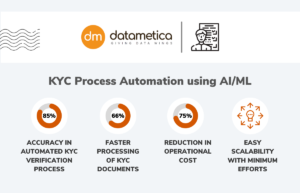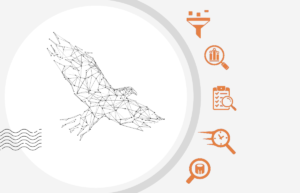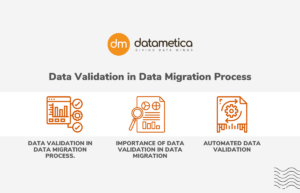Unlock your business efficiency with ETL modernization and cloud migration. Optimize workflows through automated code conversion and ETL conversion automation.
According to Gartner, by 2025, 95% of the digital workloads will be deployed on cloud-native platforms. So, the rise of the cloud is now an inevitable fact for modern business and not merely a movement. Businesses have to make full use of the cloud’s limitless computing capabilities due to the volume of customer data, the substantially increased number of data sources, and supply chain distractions.
Businesses need real-time data processing in order to scale and provide decision-makers with data more quickly in order to stay competitive. However, traditional extract, transform, and load (ETL) systems continue to be a hurdle for many when it comes to cloud migration, cloud utilization, and data integration.
In the dynamic landscape of data management, the need for efficient and scalable Extract, Transform, and Load (ETL) processes has never been more critical. The Gartner report mentioned above highlights the accelerating trend toward cloud-based data integration strategies. Businesses are constantly evolving, and so should their data integration approaches. In this blog, let’s dive into the details of ETL modernization and migration and how you can simplify the complex journey.
Weaknesses of Traditional ETLs
Let’s start by discussing why there has evolved a need to modernize or replace the traditional ETLs. Traditional ETL processes have long been the backbone of data integration, but they come with their own set of limitations. Following are the limitations that have made traditional ETLs a boon rather than a blessing for modern businesses aiming to enhance their capabilities with digital transformation.
- Batch-Oriented Processing
Traditional ETL processes operate in a batch-oriented fashion, introducing latency in data availability and hindering real-time decision-making.
- Scalability Issues
As data volumes grow, traditional ETL systems often struggle to scale seamlessly, leading to performance bottlenecks and increased infrastructure costs.
- Rigidity and Lack of Agility
The monolithic nature of traditional ETL architectures makes adapting to changes in data sources, structures, or business requirements a cumbersome task, hindering organizational agility.
- Time and Cost
These are the primary reasons cited by companies for migrating their legacy ETLs and systems to the cloud. A user’s perspective of legacy ETL platforms is that they are slow. Timelines become an important driver of pain for an organization when it has tens of thousands of ETL tasks to move data or apps to the cloud. Growing businesses also suffer significant financial challenges due to license costs for platforms such as Informatica, Datastage, and other legacy ETL solutions. These tools require servers and storage to be invested in because they have data transformation engines built in. An additional time-consuming and expensive challenge is maintaining and updating these systems. Modern ETL platforms, or their equivalents, such as Dataflow and DataPrep on Google Cloud, have infrastructure costs covered by the provider.
Common ETL Modernization Mistakes
Because of the above-mentioned reasons, businesses choose to modernize or migrate their ETLs. But as organizations embark on the journey of modernizing their ETL processes, certain common mistakes can impede progress.
- Incomplete Understanding of Workflows
Underestimating the complexity of existing ETL workflows can lead to disruptions during the migration process, highlighting the importance of a thorough understanding of dependencies and data lineage.
- Inadequate Testing
Incomplete or inadequate testing can result in data inconsistencies, errors, and performance issues in the modernized system, emphasizing the need for comprehensive testing at various levels.
- Lack of Communication and Collaboration
Insufficient collaboration between IT teams and business stakeholders can lead to misaligned priorities and objectives, underscoring the importance of involving all relevant parties from the early stages of the modernization project.
Challenges of ETL Modernization and Migration to the Cloud
- Data Volume and Velocity:
Scalability: Cloud environments offer scalability, but handling large volumes of data and high velocities requires careful planning. Ensuring that the cloud infrastructure can scale to accommodate varying workloads is crucial.
- Data Integration and Compatibility:
Data Compatibility: Different cloud platforms may have different data storage formats, and ensuring compatibility between on-premises data sources and cloud storage can be challenging.
- Data Security and Compliance:
Security Concerns: Moving data to the cloud raises security concerns, including data breaches and unauthorized access. Implementing robust security measures and encryption is essential.
Compliance: Ensuring compliance with industry regulations and data protection laws when handling sensitive data becomes more critical in a cloud environment.
- Data Quality and Consistency:
Data Quality Assurance: Maintaining data quality during the ETL process is challenging. Ensuring consistency and accuracy while moving and transforming data in a distributed cloud environment is crucial.
- Performance Optimization:
Network Latency: The speed of data transfer between on-premises and cloud environments can be affected by network latency. Optimizing performance requires considering network capabilities and utilizing appropriate cloud resources.
- Cost Management:
Cost of Resources: Cloud services are pay-as-you-go, and managing costs can be challenging. Understanding the pricing model of cloud services and optimizing resource usage are crucial to avoiding unexpected expenses.
- Skill Sets:
Skill Gap: Migrating to the cloud may require new skills and expertise. Ensuring that the team is adequately trained and has the necessary knowledge to work with cloud-based ETL tools is essential.
- Downtime and Business Continuity:
Downtime Risk: Migrating ETL processes can result in downtime, impacting business operations. Planning for minimal disruption and implementing robust business continuity measures is vital.
How Can Automated Code Conversion Tools Simplify ETL Modernization and Migration?
Automated code conversion tools play a significant role in simplifying the ETL modernization and migration processes. These tools help streamline the transition from on-premises systems to cloud environments by automating the conversion of legacy code to formats compatible with cloud-based ETL platforms. Here are several ways in which automated code conversion tools can simplify ETL modernization and migration.
- Language and Syntax Conversion:
Automated tools can translate ETL code written in one programming language or syntax to another, facilitating compatibility between on-premises and cloud environments. - Accelerated Migration:
Manual code conversion can be time-consuming and error-prone. Automated tools significantly accelerate the migration process by quickly converting code, reducing the overall project timeline. - Minimized Human Error:
Automation reduces the likelihood of human errors during the code conversion process. Consistency in code translation helps avoid issues that may arise from manual mistakes. - Compatibility with Cloud Services:
Automated tools are designed to convert code to be compatible with specific cloud-based ETL platforms. This ensures that the migrated ETL processes seamlessly integrate with the chosen cloud services. - Metadata Handling:
ETL processes often involve metadata management. Automated tools can handle the conversion of metadata definitions, ensuring that data structures are accurately represented in the new cloud environment. - Identification and Resolution:
Automated tools can analyze dependencies within the existing ETL code and resolve them during the conversion process. This helps avoid issues related to missing dependencies or incomplete code. - Cloud-native Optimization:
Automated tools can optimize ETL code for cloud architectures, taking advantage of specific features and capabilities offered by cloud platforms. This ensures optimal performance in the new environment. - Configurability:
Some tools offer customization options, allowing organizations to adapt the automated conversion process to their specific requirements. This flexibility is crucial for handling unique aspects of ETL code. - Schema and Data Type Mapping:
Automated tools facilitate seamless schema and data type mapping between source and target systems, ensuring data integrity and accuracy during the migration process.
While automated code conversion tools offer numerous benefits, it’s important to note that they are not a one-size-fits-all solution. Careful consideration of the specific requirements, the complexity of the existing ETL code, and the nuances of the target cloud environment is essential for a successful migration.
Why is Datametica’s Raven the Automated Code Converter for You?
Datametica’s Raven is an IP-driven state-of-the-art technology for automated code and ETL transformation, streamlining the code conversion process during cloud migration. This automated code converter significantly reduces the time required for code transformation and ensures the establishment of a system-wide standard for the converted tool. Raven proficiently transforms custom expressions and non-SQL ETL workflow components.
Raven efficiently converts ETL into ELT-based scripts that align with the selected cloud platform, providing a swift and reliable transformation. By decoupling extraction and loading processes and keeping them on-premises, Raven ensures that only the transformation phase occurs on the cloud platform, where data is re-coded. This conversion from ETL to ELT eliminates the need for network bandwidth and mitigates potential performance issues. The automated methods employed by Raven minimize the dependence on technical expertise from both source and destination systems, along with reducing the associated costs of the migration’s code conversion process.
Raven utilizes a canonical model for executing one-to-one pipelines during the conversion of legacy code to the target platform. This canonical model is generated by analyzing the metadata of the legacy data and is entirely independent of the source platform. Subsequently, this model is transformed into system code for implementation.
Datametica’s Raven is a proven code conversion service that comes with a 100% code conversion guarantee. Datametica has used Raven in numerous projects, from end to end cloud migration to just code conversion and optimization. You can check out the case studies of the projects that Datametica has successfully delivered
To learn more about Raven – The Automated Code Transformer, read our whitepaper or Get in touch.
Closing Lines
ETL modernization and cloud migration represent a critical phase in the evolution of data integration strategies. Recognizing the weaknesses of traditional ETL, avoiding common modernization mistakes, implementing a proven strategy, and leveraging an automated code conversion tool like Raven can collectively lead to a successful transformation. Raven serves as a beacon, guiding organizations through the intricate journey of ETL modernization and unlocking the full potential of modern data management in the cloud.
.
.
.
About Datametica
A Global Leader in Data Warehouse Modernization & Migration. We empower businesses by migrating their Data/Workload/ETL/Analytics to the Cloud by leveraging Automation.




3 Comments